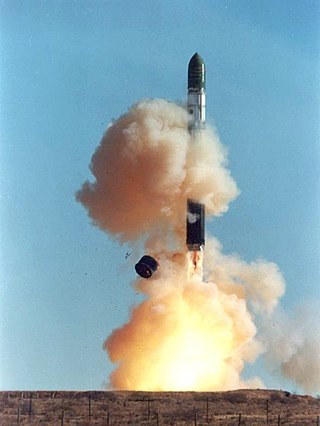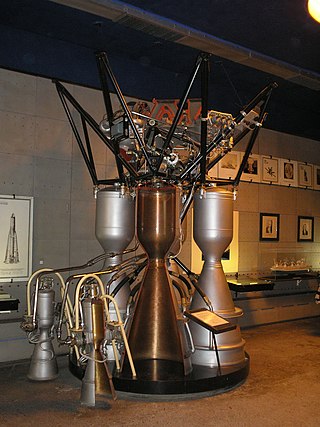
The R-36 is a family of intercontinental ballistic missiles (ICBMs) and space launch vehicles (Tsyklon) designed by the Soviet Union during the Cold War. The original R-36 was deployed under the GRAU index 8K67 and was given the NATO reporting name SS-9 Scarp. It was able to carry three warheads and was the first Soviet MRV missile. The later version, the R-36M, also known as RS20, was produced under the GRAU designations 15A14 and 15A18 and was given the NATO reporting name SS-18 Satan. This missile was viewed by certain United States analysts as giving the Soviet Union first strike advantage over the U.S., particularly because of its rapid silo-reload ability, very heavy throw weight and extremely large number of re-entry vehicles. Some versions of the R-36M were deployed with 10 warheads and up to 40 penetration aids and the missile's high throw-weight made it theoretically capable of carrying more warheads or penetration aids. Contemporary U.S. missiles, such as the Minuteman III, carried up to three warheads at most.

The NK-33 and its vacuum-optimized variant, the NK-43, are rocket engines developed in the late 1960s and early 1970s by the Kuznetsov Design Bureau for the Soviet space program's ill-fated N1 Moon rocket. The NK-33 is among the most powerful LOX/RP-1 powered rocket engines ever built, noted for its high specific impulse and low structural mass.

The RD-8 is a Soviet / Ukrainian liquid propellant rocket engine burning LOX and RG-1 in an oxidizer rich staged combustion cycle. It has a four combustion chambers that provide thrust vector control by gimbaling each of the nozzles in a single axis ±33°. It was designed in Dnipropetrovsk by the Yuzhnoye Design Bureau as the vernier thruster of the Zenit second stage. As such, it has always been paired with the RD-120 engine for main propulsion.

The RD-58 is a rocket engine, developed in the 1960s by OKB-1, now RKK Energia. The project was managed by Mikhail Melnikov, and it was based on the previous S1.5400 which was the first staged combustion engine in the world. The engine was initially created to power the Block D stage of the Soviet Union's abortive N1 rocket. Derivatives of this stage are now used as upper stages on some Proton and Zenit rockets. An alternative version of the RD-58 chamber, featuring a shorter nozzle, was used as the N1's roll-control engine.

The RD-107 and its sibling, the RD-108, are a type of rocket engine used on the R-7 rocket family. RD-107 engines are used in each booster and the RD-108 is used in the central core. The engines have four main combustion chambers and either two (RD-107) or four (RD-108) vernier chambers.

The RD-253 and its later variants, the RD-275 and RD-275M, are liquid-propellant rocket engines developed in the Soviet Union by Energomash. The engines are used on the first stage of the Proton launch vehicle and use an oxidizer-rich staged combustion cycle to power the turbopumps. The engine burns a hypergolic mixture of unsymmetrical dimethylhydrazine (UDMH) fuel with dinitrogen tetroxide oxidizer, which are highly toxic, but storable at room temperature.
The RD-120 is a liquid upper stage rocket engine burning RG-1 and LOX in an oxidizer rich staged combustion cycle with an O/F ratio of 2.6. It is used in the second stage of the Zenit family of launch vehicles. It has a single, fixed combustion chamber and thus on the Zenit it is paired with the RD-8 vernier engine. The engine was developed from 1976 to 1985 by NPO Energomash with V.P. Radovsky leading the development. It is manufactured by, among others, Yuzhmash in Ukraine.
The RD-0214 (Russian: Ракетный Двигатель-0214 [РД-0214], romanized: Raketnyy Dvigatel-0214, lit. 'Rocket Engine 0214', GRAU index: 8D811) is a vernier thruster rocket engine burning unsymmetrical dimethylhydrazine (UDMH) fuel with dinitrogen tetroxide (N2O4) oxidizer in a gas-generator cycle. It has four nozzles that can each gimbal 45 degrees in plane to provide thrust vectoring control to the RD-0212 propulsion module of Proton rocket's third stage. It is a revised version of the RD-0207 (Russian: РД-0214, GRAU index: 8D67).

The RD-0210 (Russian: Ракетный Двигатель-0210, romanized: Raketnyy Dvigatel-0210, lit. 'Rocket Engine 0210', GRAU index: 8D411K) is also known as the RD-465. It and its twin, the RD-0211, are rocket engines using unsymmetrical dimethylhydrazine (UDMH) as fuel and dinitrogen tetroxide (N2O4) as oxidizer in an oxidizer rich staged combustion cycle. They have a single nozzle, possess thrust vectoring and are the latest evolution in the RD-0203/4 lineage. They are the engines used on the Proton second stage. The RD-0213 is a fixed nozzle variation that is used on the RD-0212 module of the Proton third stage.
The RD-0216 (Russian: Ракетный Двигатель-0216, romanized: Raketnyy Dvigatel-0216, lit. 'Rocket Engine 0216') and RD-0217 are liquid rocket engines, burning N2O4 and UDMH in the oxidizer rich staged combustion cycle. The only difference between the RD-0216 and the RD-0217 is that the latter doesn't have a heat exchanger to heat the pressuring gasses for the tanks. Three RD-0216 and one RD-0217 were used on the first stage of the UR-100 ICBM. The engines were manufactured until 1974 and stayed in operational use until 1991. More than 1100 engines were produced.
The RD-0233 and RD-0234 are liquid-fueled rocket engines which burn a hypergolic mixture of unsymmetrical dimethylhydrazine (UDMH) fuel with dinitrogen tetroxide oxidizer in an oxidizer-rich staged combustion cycle. The only difference between the RD-0233 and the RD-0234 is that the latter has a heat exchanger to heat the pressuring gasses for the tanks. Three RD-0233 and one RD-0234 are used on the first stage of the UR-100UTTKh ICBM. While the engine is out of production, the ICBM as well as Rokot and Strela remain operational as of 2015.

The RD-119 was a liquid rocket engine, burning liquid oxygen and UDMH in the gas-generator cycle. It has a huge expansion ratio on the nozzle and uses a unique propellant combination to achieve an extremely high isp of 352 s for a semi-cryogenic gas-generator engine. It also has a unique steering mechanism. The engine main nozzle is fixed, and the output of the gas generator is fed into four nozzles on the side of the engine. Instead of using gimbaled verniers to supply vector control, the combustion gases are distributed by an electrically driven system that can control the thrust among the nozzles.

The RD-214 (GRAU Index 8D59) was a liquid rocket engine, burning AK-27I (a mixture of 73% nitric acid and 27% N2O4 + iodine passivant and TM-185 (a kerosene and gasoline mix) in the gas generator cycle. As was the case with many V-2 influenced engines, the single turbine was driven by steam generated by catalytic decomposition of hydrogen peroxide. It also had four combustion chambers and vector control was achieved by refractory vanes protruding into the nozzle's exhaust.

The RD-250 is the base version of a dual-nozzle family of liquid-fuel rocket engines, burning a hypergolic mixture of unsymmetrical dimethylhydrazine (UDMH) fuel with dinitrogen tetroxide oxidizer in an gas-generator open cycle. The RD-250 was developed by OKB-456 for Yangel's PA Yuzhmash ICBM, the R-36 (8K67). Its variations were also used on the Tsyklon-2 and Tsyklon-3 launch vehicles. It was supposed to be used on the Tsyklon-4, but since the cancellation of the project it should be considered as out of production.

The RD-215 was a dual nozzle liquid-fuel rocket engine, burning a hypergolic mixture of unsymmetrical dimethylhydrazine (UDMH) fuel with AK-27 oxidizer. It was used in a module of two engines known as the RD-216. The RD-215 was developed by OKB-456 for Yangel's Yuzhmash R-14 (8K65) ballistic missile. Its variations were also used on the Kosmos-1, Kosmos-3 and Kosmos-3M launch vehicles.
The RD-861 is a Soviet liquid propellant rocket engine burning a hypergolic mixture of unsymmetrical dimethylhydrazine (UDMH) fuel with dinitrogen tetroxide oxidizer in a gas generator combustion cycle. It has a main combustion chamber, with four vernier nozzles fed by the gas generator output. It can be reignited a single time.
The RD-855, also known as the RD-68M, is a liquid-fueled rocket engine with four nozzles. As a vernier engine, it provides fine steering adjustments for rockets. It is powered by a hypergolic mixture of unsymmetrical dimethylhydrazine (UDMH) fuel with dinitrogen tetroxide oxidizer. This combination is hypergolic, meaning the two substances ignite on contact, eliminating the need for an external ignition source.
The RD-856, also known as the RD-69M, is a four-nozzle liquid-fuel rocket vernier engine, burning a hypergolic mixture of unsymmetrical dimethylhydrazine (UDMH) fuel with dinitrogen tetroxide oxidizer in a gas generator cycle. It was used on the R-36, Tsyklon-2 and Tsyklon-3 second stage as thrust vector control by gimbaling of its nozzle. The engine is distributed through a cylindrical structure that is integrated around the main engine RD-252 module. The structure includes aerodynamic protection for the nozzles. The engine was started by a pyrotechnic ignitor.
The RD-0255 is a propulsion module composed of an RD-0256 main engine and a RD-0257 Vernier thruster. Both are liquid-fuel rocket engines, burning a hypergolic mixture of unsymmetrical dimethylhydrazine (UDMH) fuel with dinitrogen tetroxide oxidizer. The RD-0256 main engine operates in the oxidizer rich staged combustion cycle, while the vernier RD-0257 uses the simpler gas generator cycle. It was used on the R-36MUTTKh (GRAU:15A18) and R-36M2 (GRAU:15A18M). Subsequently, it has been in the Dnepr second stage and as of 2016 it is still in active service.
The RD-864 is a Soviet liquid-fuel rocket engine burning a hypergolic mixture of unsymmetrical dimethylhydrazine (UDMH) fuel with dinitrogen tetroxide oxidizer in a gas generator combustion cycle. It has a four combustion chambers that provide thrust vector control by gimbaling each nozzle in a single axis ±55°. It is used on the third stage of the R-36M UTTKh and Dnepr. For the R-36M2, an improved version, the RD-869 was developed.











